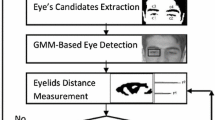Abstract
Sophisticated mathematical algorithms (such as differencing, thresholding, aggregation and statistical analysis of skin colours) are used to compare successive frames of computer-captured images of the face. From these, changes in state of the eyes are determined and are used to detect blinks. A recognition performance of 83.74±0.03% is achieved over five subjects with a low rate of false positives 2.71±0.01%. A logical decision rule identifies purposeful blinks and applies them to control either a custom-designed communication package or an external device.
Similar content being viewed by others
References
Clarke, L., Harper, P., andReilly, R. (1998): ‘Video based gesture recognition for augmentative communication’. TIDE Third Congress Papers, Helisinki
Cleveland, N. R., andDoyle, P. G. (1992): ‘Eyegaze communication system, How does it work? Who can use it?’. Closing the gap — 10th Annual Conference, Minneapolis, Minnesota, Oct. 22–24, 1992
Gonales, R. C., andWintz, P. (1987): ‘Digital image processing’, (Addison-Wesley), 2nd edn
Miyazaki, S., Ishida, A., andKomatsuzaki, A. (2000): ‘A clinically oriented video-based system for quantification of eyelid movements’,IEEE Trans. Biomed. Eng.,47, pp. 1088–1096
Author information
Authors and Affiliations
Corresponding author
Rights and permissions
About this article
Cite this article
Burke, D., Ward, T. & de Paor, A. Image processing used to harness blinking as a channel of communication and control for physically disabled people. Med. Biol. Eng. Comput. 39, 285–287 (2001). https://doi.org/10.1007/BF02345281
Received:
Accepted:
Issue Date:
DOI: https://doi.org/10.1007/BF02345281




